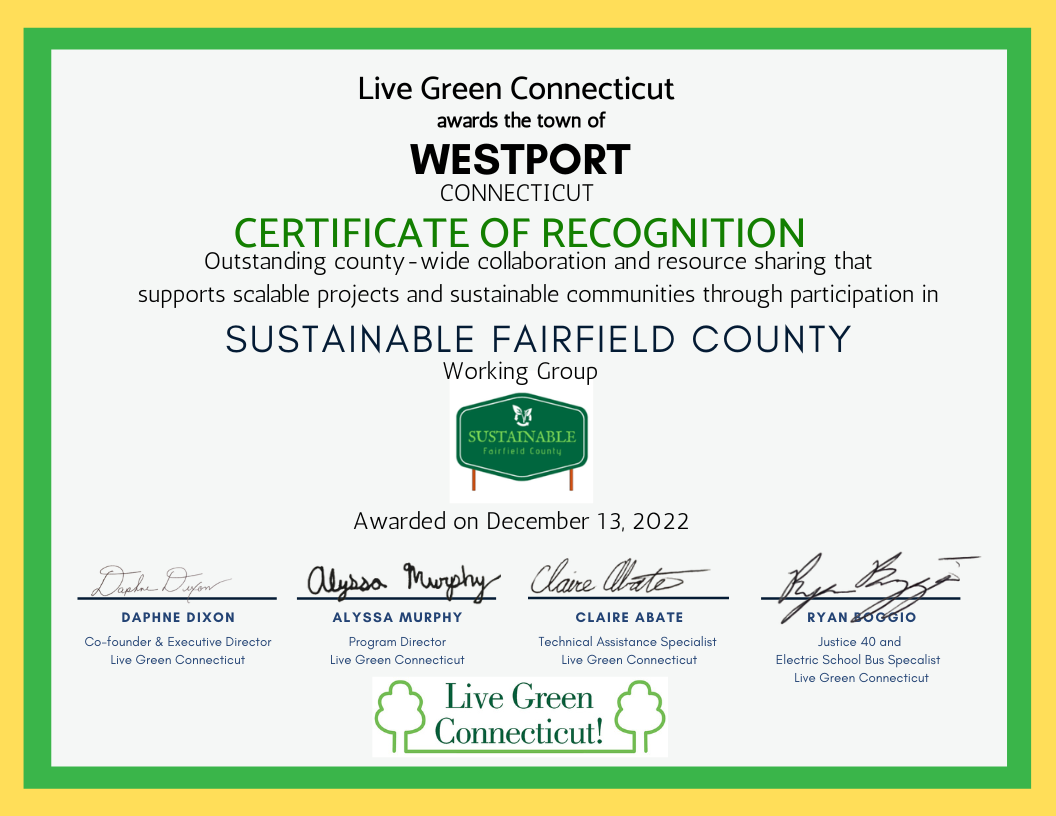Container, 1 column
1 column
1/2 column
1/2 column
1/3 column
1/3 column
1/3 column
1/3 column
2/3 column
1/4 column
1/4 column
1/4 column
1/4 column
1/4 column
3/4 column
1/5 column
1/5 column
1/5 column
1/5 column
1/5 column
1/5 column
4/5 column
1/6 column
1/6 column
1/6 column
1/6 column
1/6 column
1/6 column
1/6 column
5/6 column
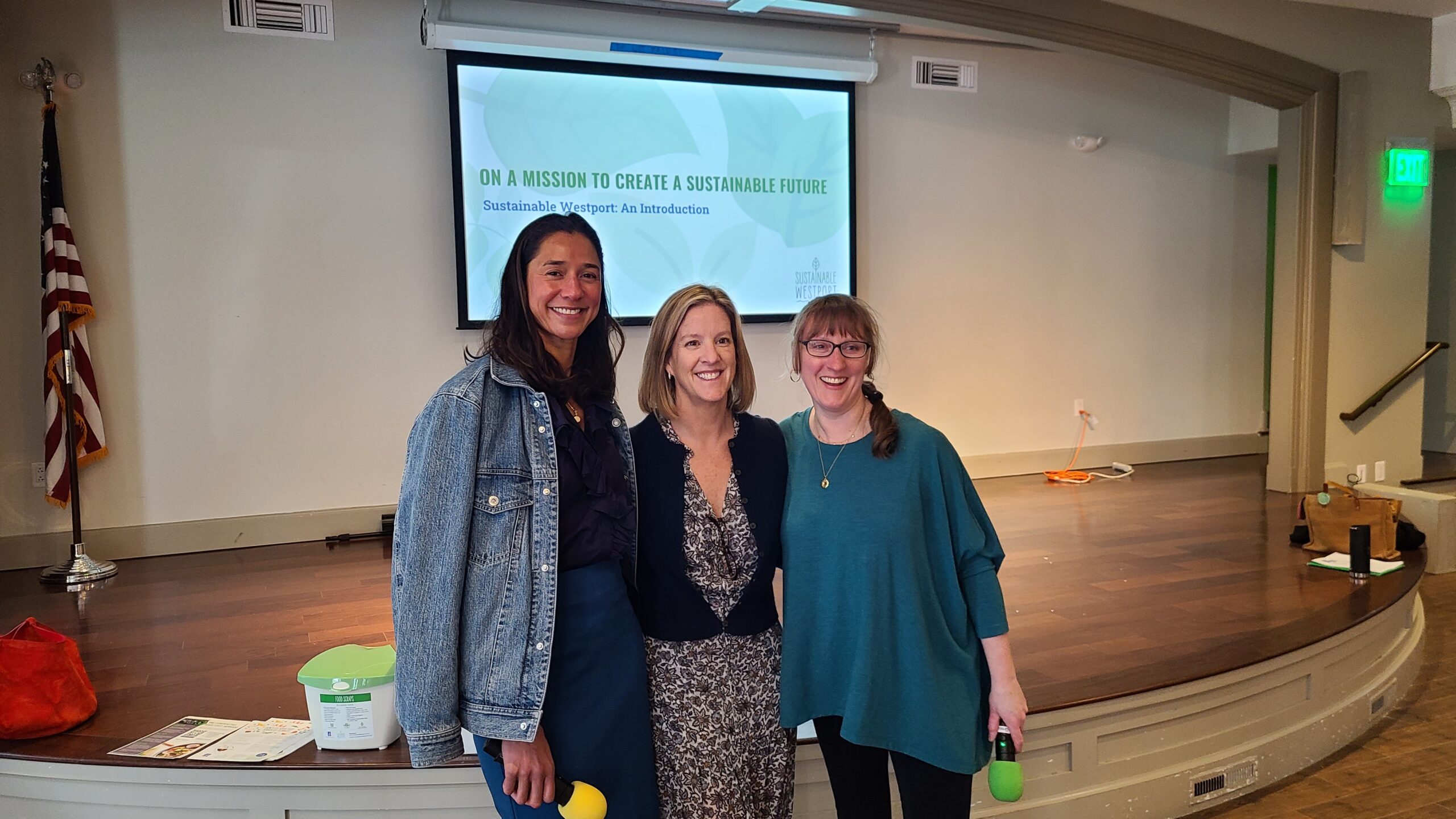
Sustainable Westport Envisions a More Sustainable Future at Saugatuck Church
Saugatuck Church Reverend Alison Patton invited Sustainable Westport Co-Directors Gately Ross and Johanna Martell to their seasonal series entitled “Picture This,” in which Westport-area community leaders share insights on a variety to topics during Sunday service.
Rev. Patton facilitated a conversation based on the prompt “Picture This: A world in which our work towards a more sustainable Westport had all its intended impact.” Gately and Jo helped parishioners envision the future of Westport as a net zero community through the implementation of sustainable practices, answered questions, and joined the parish for a social hour where they shared information about recycling and Westport’s food scrap collection program.
Special shout out to Saugatuck Church for offering a zero-waste social hour after each service!
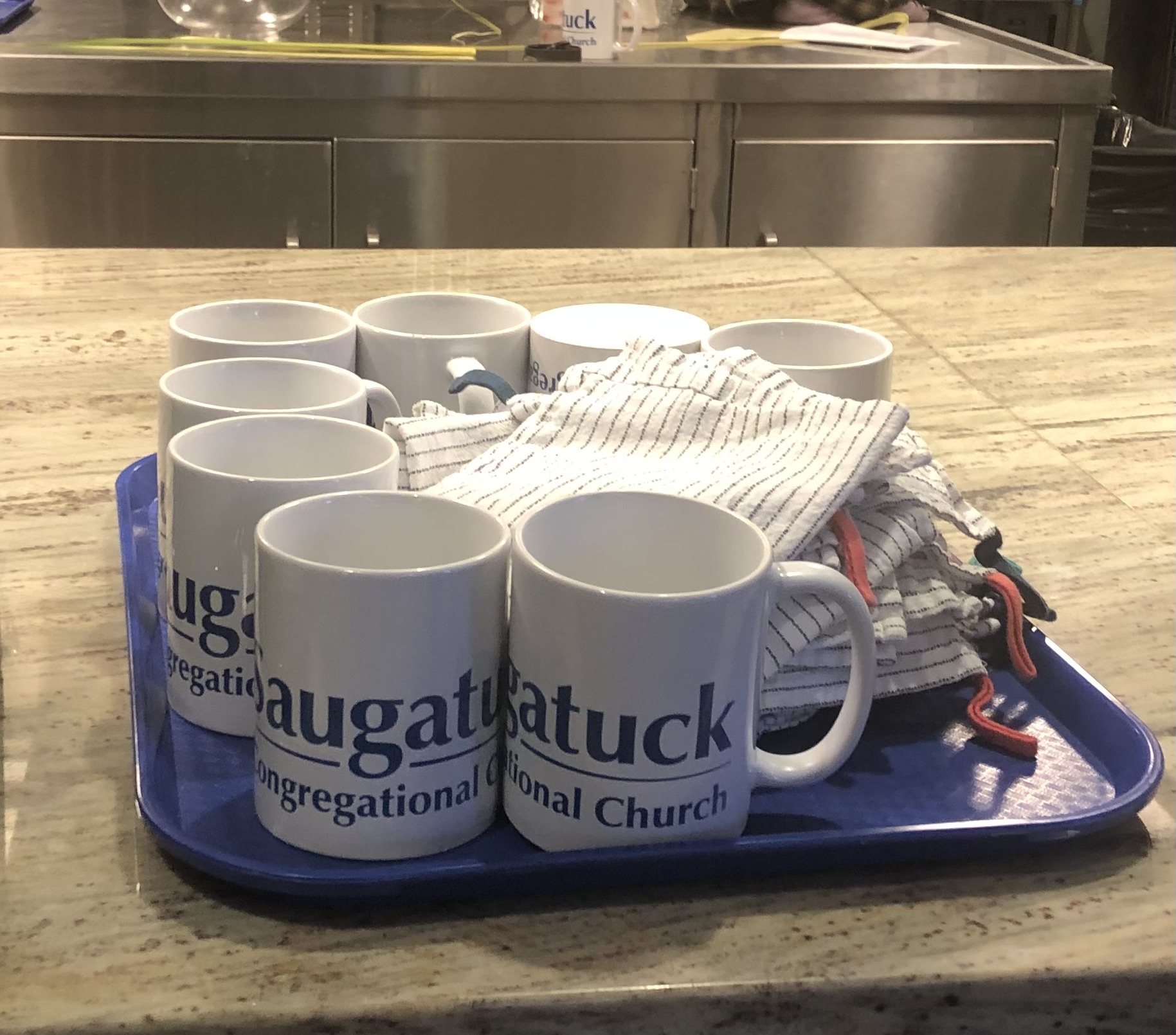
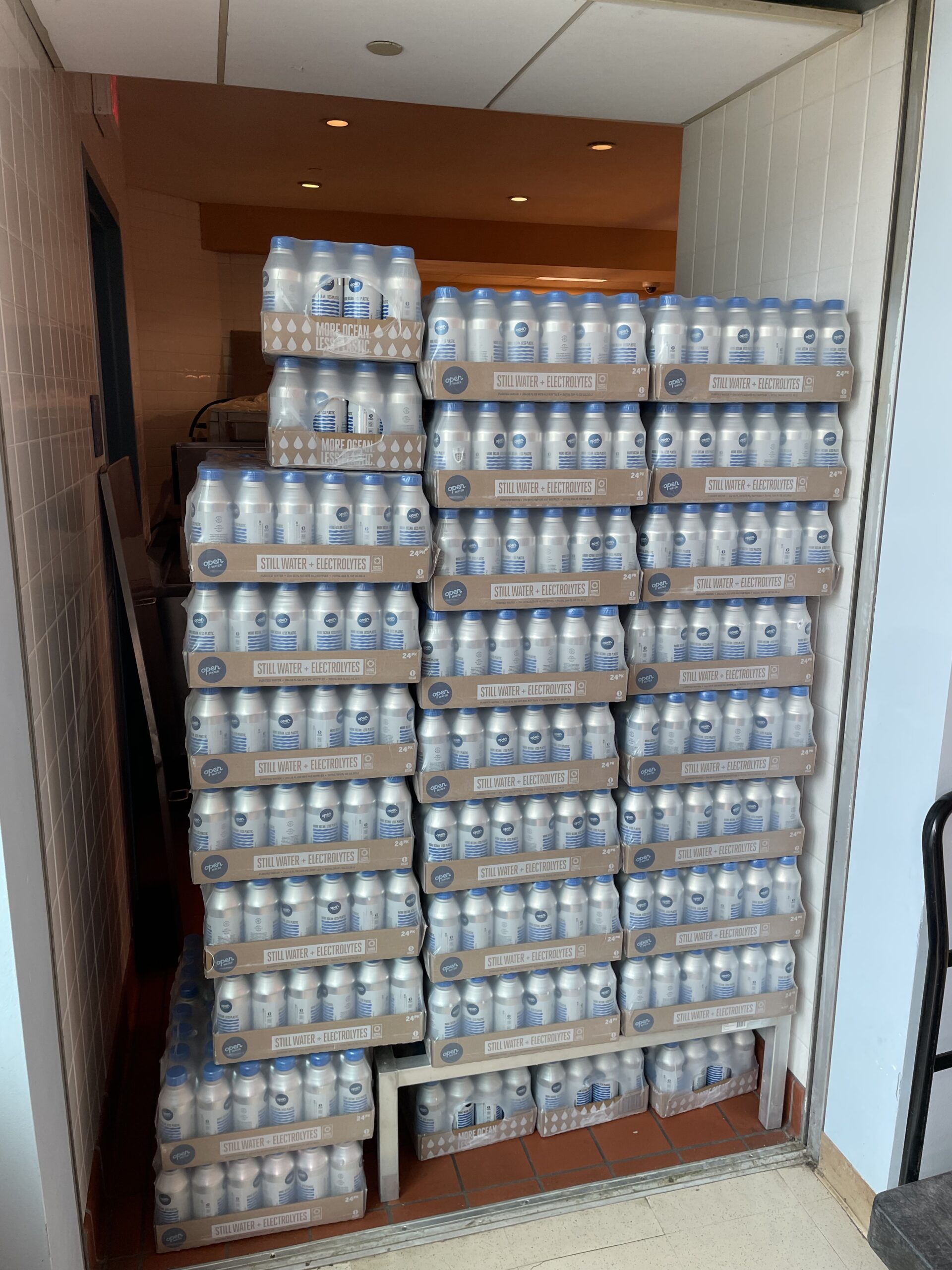
Sustainable Westport Superstar: The Staples Players
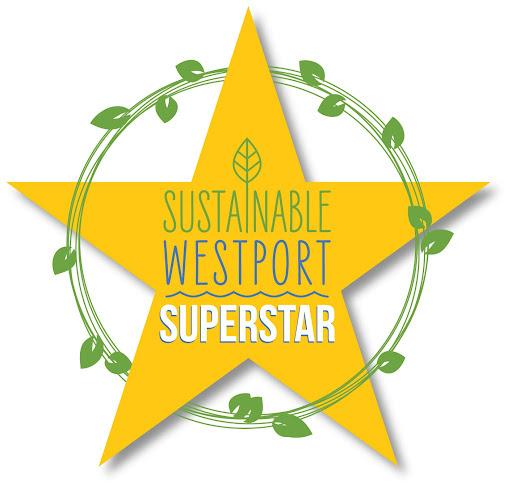
The Westport High School theater group, known as the Staples Players, along with the Staples Players Booster Organization recently announced the move to more sustainable concession practices for their upcoming performances of TWELFTH NIGHT.
While busy preparing for a rousing modern musical adaptation of Shakespeare’s romantic comedy, the Staples Players also explored options to transition their concessions away from single-use plastic. Each academic year, the Staples Players Booster Organization sells around 3,000 single-use water bottles during concessions at their main stage productions. This represents a substantial revenue source, which allows the Staples Players to offer Broadway-quality productions for the community. However, according to the Container Recycling Institute, only 12% of disposable water bottles used in the United States are recycled; meaning 86% of disposable water bottles end up as litter or in a landfill.
After exploring and researching several alternatives, the Staples Players and the Staples Players Booster Organization selected a BPA-Free aluminum water product to replace the traditional plastic bottles offered at concessions. Aluminum cans/bottles are created from 68% recycled content and are infinitely recyclable, which makes them one of the most valuable commodities in the recycling system.
This change represents a small but important commitment to identifying sustainable alternatives for all Westport High School theater productions. Help support the Staples Players by attending their upcoming adaptation of TWELFH NIGHT, and be sure to stop by the concession stands to see this sustainable change in action.
THANK YOU to the Staples Players for being a Sustainable Westport Superstar!
More Water Bottle Recycling Facts from the Sierra Club:
The U.S. recycling system is currently unable to recycle even a quarter of plastic water bottles and lacks the capacity to recycle more than 12 percent of the bottle caps. Even the portion that does get recycled is never “100 percent recyclable”— of the plastic water bottles that get recycled, about 28 percent of the material is lost to processing or contamination and ends up in landfills. In a final irony, the polypropylene plastic film labels on which the “100 percent recyclable” claims are printed on the bottles are themselves completely unrecyclable.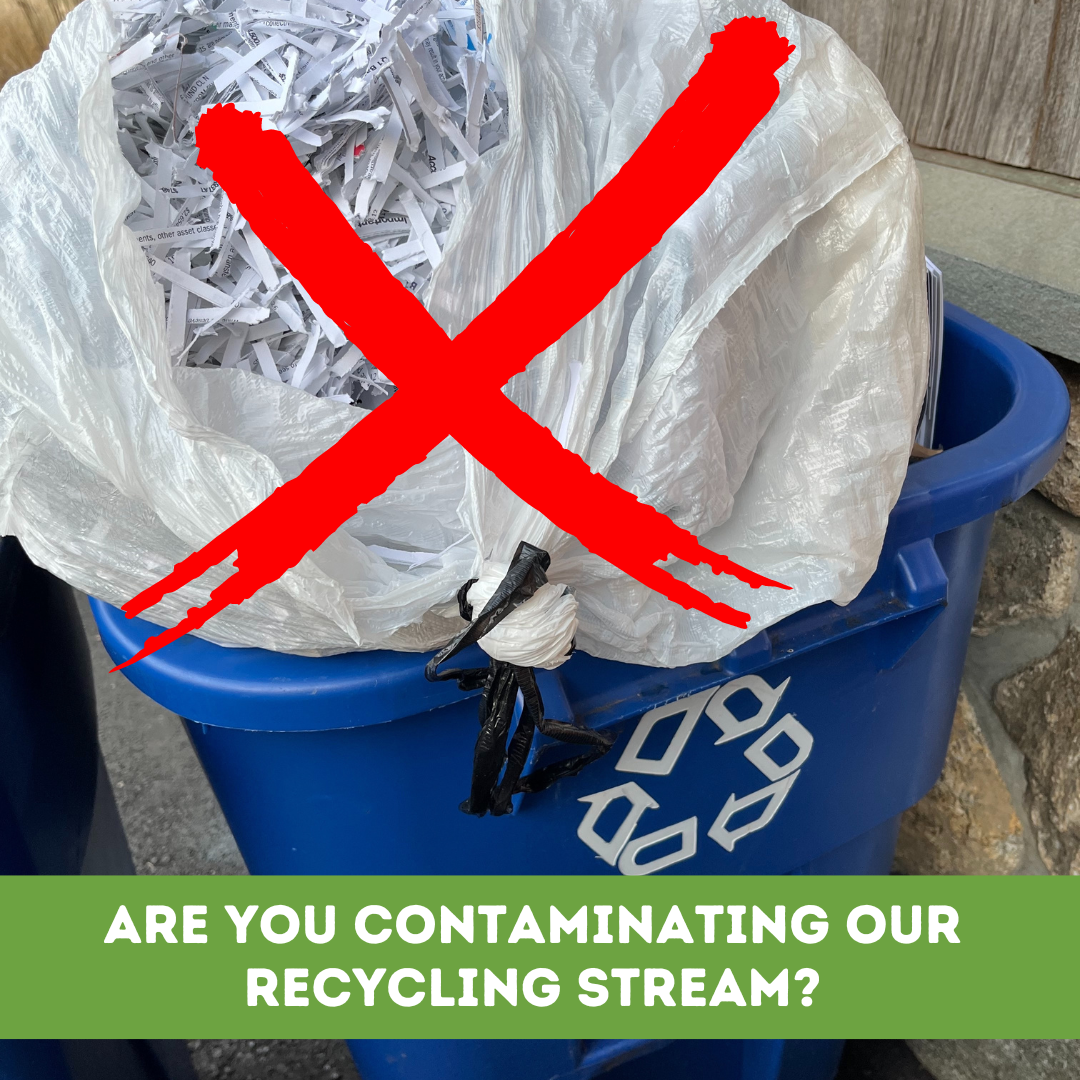
Single Stream Recycling, Contamination, and “How to Recycle Right”
One of the most frequent questions/complaints that we hear about recycling is “IT IS SO CONFUSING!!! I don’t even know if I’m doing it right?!”. And, the honest truth is that it is confusing. And nuanced.
Many people are unsure about which items can be recycled via single-stream (in the blue bins), which need to be recycled separately, and which items are not recyclable at all. Rather than continuing to guess or “wishcycle,” it is critical that we learn how to “recycle right.” Why? If we don’t “keep the stream clean” ALL of our recycling (even the good stuff) ends up in the trash.
What is single-stream recycling?
Single-stream recycling (or “mixed” recycling) is a system in which recyclable materials such as cardboard, paper, plastic, metal, and glass containers are collected together for processing.
Although we have been recycling for decades, many people are unaware of what happens to these materials after they are picked up in our blue bins or dropped off at the Transfer Station.
Once your recycled goods make it to the Westport Transfer Station (either by a hauler or by being dropped off), the mixed single-stream recycling is transported directly to the Oak Ridge Materials Recovery Facility (MuRF) in Shelton, CT by Enviro Express (no sorting takes place at the Westport Transfer Station). From there, Oak Ridge sorts the recycling by material into various “streams” like paper, corrugated cardboard, aluminum, metal, glass, and plastic. There are multiple types of plastic recycling streams, which are identified by the numbers 1-7 (resin codes) imprinted on the bottom of the material.
Once separated, the materials are then processed to market conditions and baled in preparation to be sold on the market. The value of each commodity varies based on the current market rate. Once sold, the materials are then shipped to manufacturers that utilize the recovered materials to produce new products.
Why is recycling so confusing?
Recycling can be confusing and nuanced. Many people are unsure which items can be recycled via a single stream, which items need to be recycled separately, and which items are not recyclable at all.
Due to a lack of federal oversight, recycling is not centrally regulated or mandated. As a result, recycling varies not only from state to state but even from municipality to municipality! Even the recycling symbol itself is unregulated, which allows manufacturers the ability to widely and intentionally misrepresent their products (called greenwashing) as recyclable, when in fact, they are not.
The lack of standard recycling procedures and regulations across the country (or even state) paired with misinformation and greenwashing, makes “recycling right” a challenge. The result? Many items that cannot be recycled end up at our single-stream recycling centers, contaminating the items that CAN be recycled, lowering the value of our good recycling, and causing loads of recycling to end up being diverted to the trash.
“Recycling right” is a critical first step that is often misunderstood. If we don’t “keep the stream clean” ALL of our recycling (even the good stuff) ends up in the trash.
What is contaminating our recycling?
Oak Ridge, our local Materials Recycling Facility (MuRF), identifies two types of contamination in Westport’s single-stream recycling:
Residual waste is generated in each commodity (ex. plastic, glass, cardboard) stream and is somewhat expected. Examples include ripped pieces of paper or cardboard, shards of glass that can’t easily be separated, and bottle caps that get entwined in paper waste.
Unacceptable material are items that are not processed at the MuRF. These items cannot be recycled and contaminate the good recyclables. The majority of unacceptable material ends up at the MuRF with the best intentions. People are unaware or unsure if an item is accepted, so they throw it in the blue bin hoping that the item will be recycled. This wishful thinking, called “wishcycling” is a significant problem.
In addition to actual bags of trash that accidentally make their way to the MuRF, the most common single-stream recycling contaminants / “wishcycled” items are:
- Plastic bags and plastic film/wrap
- Garden hoses and electric cords
- Shredded Paper
- Household Items: coffee maker, laundry baskets
- Children’s plastic toys
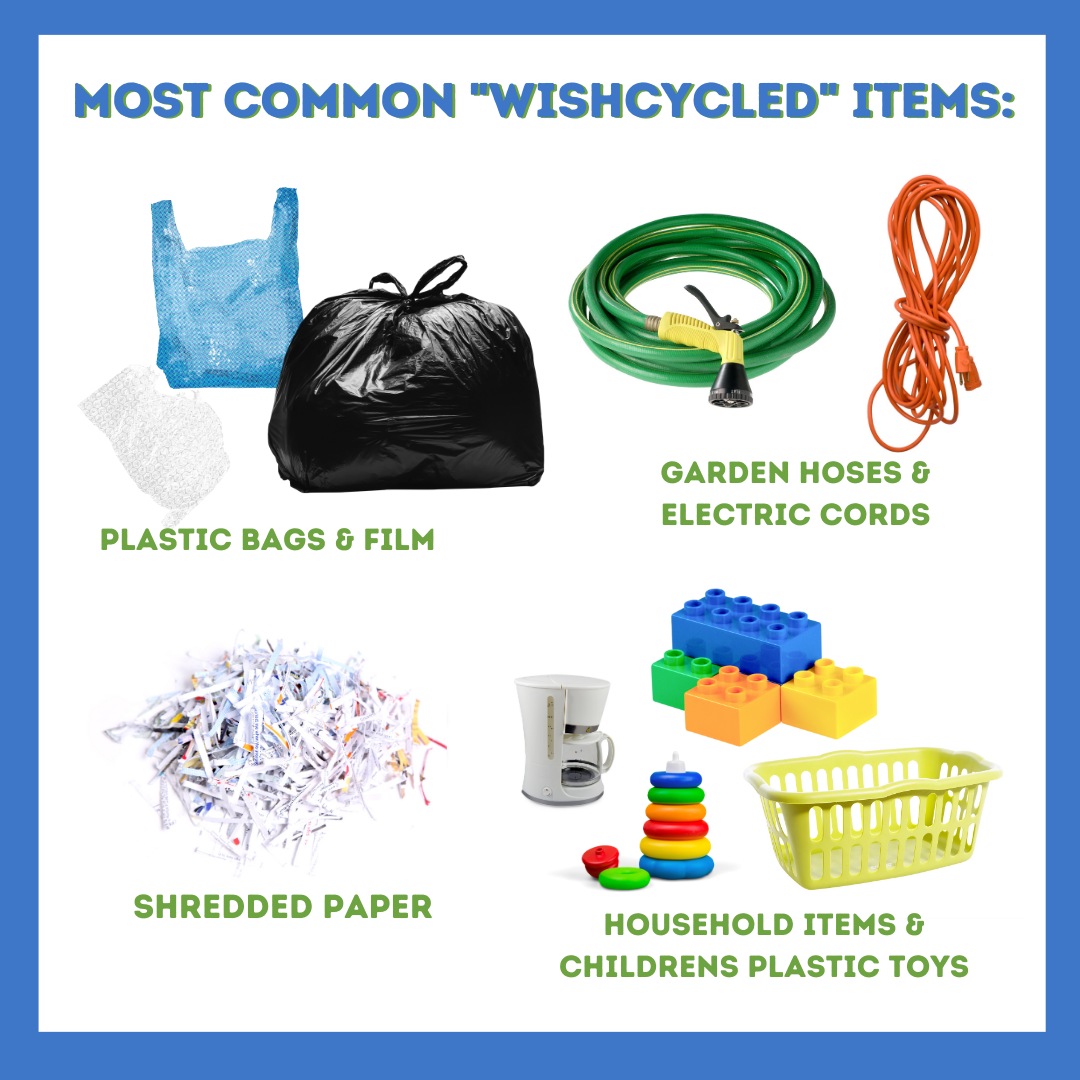
What happens when single-stream recycling is contaminated?
Many people, particularly those that “wishcycle” believe that attendants at the MuRF will sort through their recycling and pull out anything that cannot be recycled. This is not the case. In Westport, if more than 10% of a recycling pile is deemed unacceptable material, the ENTIRE pile is diverted to the incinerator, including all the material that CAN be recycled! Currently, Oak Ridge estimates our contamination rate is between 35-39%! According to Westport’s contract with Oak Ridge, exceeding 10% of unacceptable material leads to a 15% increase in fees for the town. To date, Oak Ridge has absorbed this cost but warns that if improvements are not made imminently they will begin applying this fee, which will ultimately result in an increase in taxes.
What other items can be recycled at the Transfer Station?
In addition to collecting our single-stream recycling, the Westport Transfer station also accepts several specialty items. These items must be sorted and dropped off in the appropriate receptacles at the Transfer Station.
- Paint
- E-Waste: Electronics, including televisions, DVD players, and cell phones
- Textiles: Worn-out sneakers, beyond-repair clothing and other textiles
- Cardboard (must be clean and broken down)
- Batteries
- Light Bulbs
- Scrap Metal
- Motor Oil and Antifreeze
- Food Scraps
- Glass
How can you ensure you “Recycle Right”?
As a town, we need to do better by intentionally educating ourselves on proper recycling and not wishcycling. Here are some resources to help you get started:
- Download the What’s In and What’s Out Westport Recycling Guide to understand the “What’s In and What’s Out” of the blue bins. This printable reference guide comes in handy for items that go in your blue bin.
- Visit our website for a list of items that can be recycled separately at the transfer station or elsewhere.
- Visit the RecycleCT Recycling Wizard online or download their app to easily search for items with instructions on how to discard common materials.
- Follow @sustainablewestport on Instagram or Facebook for informative (and entertaining) posts to help you properly dispose of your waste/recycling.
- And, when all else fails abide by the adage: When in Doubt, Leave it Out.
Have a recycling question or suggestion for an upcoming newsletter or social post? You can always email Sustainable Westport at admin@sustainablewestport.org or drop us a DM on social media.

Resource Guide to Donating and Consignment
The fashion industry is the second largest polluter in the world after the oil and gas sector. Collectively, the average family in the US discards 280 lbs of clothing and textile waste each year. Additionally, a mere 15% of clothing donated to large chain organizations are put on racks for resale. The remaining 85% are landfilled in developing countries or downcycled into cheap filler for mattresses, moving blankets, and similar consumer products.
There are multiple ways to consume consciously to lessen our impact on the planet: Wearing secondhand, buying fewer but better-made pieces, and purchasing from companies committed to fair labor practices, circular production, and end-of-lifecycle solutions are just a few impactful ideas.
What we do with our clothing when it no longer serves us is a critical component of reducing textile waste. Responsible, thoughtful donating is key. I recommend donating good-quality clothing to local and niche organizations that fill a specific need within the community. Maternity and baby clothes should go to a women’s shelter; formal wear to a prom-dress collection; outerwear to a coat drive, and sneakers to footwear recycling programs.
Organizations that will reuse your goods should receive washed clothing in good condition that you’d be proud to give to a friend. So take good care of your clothes while you have them, and anything that doesn’t pass the “friends test” should be recycled or downcycled. The Westport Transfer Station accepts textiles in any condition as well as footwear, accessories (bags, gloves, scarfs), home linens, pillows, throws, and stuffed animals – as long as they are dry. Other organizations, like animal shelters, are always looking for used blankets or towels.
Always ask what an organization is seeking and make sure they are accepting donations. Keep in mind that on the other side of your donation bag is someone doing the hard work of hand-sorting your used goods for a greater cause.
LOCAL CONSIGNMENT STORES
- Around the Rosy (kidswear, toys and homegoods). 1 Turkey Hill Rd S, Westport. (203) 557-8082
- Cloud Nine Designer Consignment (womenswear and menswear, shoes and accessories). 339 Main St, Westport. (203) 293-4733
- Designer Label Consignment (womenswear and menswear, shoes and accessories. 1344 Post Rd E, Westport. (203) 255-9099
- Recycled Lines (youth and sportswear)
- Roundabout Resale Couture (womenswear and menswear, shoes and accessories).606 Post Rd E, Westport. Other locations in Greenwich and Stamford. (203) 227-4334
LOCALLY-OWNED RESALE EXPERIENCES
- Next Up is a high end, sustainable shopping experience with in-person events and a shoppable website.
- Shop Tomorrows is a national, cashless network for trading up kids wear and more.
- The Exchange Project: A shopping experience powered by sustainability for the fashion forward & environmentally conscious.
Always call or email the organization for details before donating as hours and location are subject to change.
MATERNITY AND INFANTS
Mothers for Others, Greenwich
Accepts gently used baby items (i.e. baby swings, strollers, high chairs, bouncy seats and pack-n-plays) as well as disposable diapers. No car seats, opened diaper packages, baby baths, toilet seats, cribs, or mattresses.
Hours, contact info and location(s)
Drop offs Tuesday, Wednesday or Thursday, from 10:00 a.m.- 12:00 p.m. at 2nd floor of Second Congregational Church, 139 East Putnam Ave., 203-340-1259 or email mothersforothers@yahoo.com.
ABC Women’s Center: Charitable Donations
Agency accepts donations of maternity clothes, infant clothes, women’s clothes, and children’s clothing to size 5. Donations of office equipment and computers, to support agency programs are also accepted.
Hours, contact info and location(s)
Middletown, CT. Text 860-325-2880, Voice 860-344-9292 molly@abcwomenscenter.org
Baby2Baby
Provides low-income children, ages 0-12 years, with diapers, clothing and all the basic necessities that every child deserves.
GENERAL KIDS’ CLOTHING
Clothes To Kids of Fairfield County
Mission is to provide new and quality used clothing to low income or in-crisis school ages children in Fairfield County, Ct, free of charge.
Hours, contact info and location(s)
Boys & Girls Club of Stamford, Yerwood Clubhouse, 90 Fairfield Avenue, Stamford CT 06902 / info@clothestokidsfairfieldcounty.org (203) 595-5664
Clothes to Kids
This national non-profit organization provides underprivileged local children with clothing appropriate for school. For more efficient distribution, branches are divided by state.
SPECIAL OCCASION AND SHOES
Operation Prom
This national organization takes in preloved prom gowns and tuxedos. Operation Prom National Network, Inc., helps students attend their prom by providing free dresses and tuxedos. They distribute prom formal wear as well as accessory items such as shoes, undergarments, jewelry, and bowties. hello@promnationalnetwork.org
PROFESSIONAL CLOTHING FOR MEN AND WOMEN
Dress for Success of Mid-Fairfield County
The mission of Dress for Success is to empower women to achieve economic independence by providing a network of support, professional attire and the development tools to help women thrive in work and in life.
Hours, contact info and location(s)
203.333.6505
Bridgeport (9:30 a.m. – 2:30 p.m.)
Dress for Success Mid-Fairfield County, 240 Fairfield Avenue, Bridgeport, CT 06604, (203) 333-6505
Norwalk, Westy Norwalk, Norwalk, CT 06854, (203) 899-1234
Stamford, The Loft Salon & Spa, Stamford, CT 06903 (203) 890-9494
Wilton, Westy Wilton, Wilton, CT 06897, (203) 762-7600
Save-A-Suit
Save-A-Suit is a 501(c)(3) nonprofit organization. We provide our former military and college graduates with professional business attire and the confidence needed to succeed.
Hours, contact info and location(s)
137 Greenwood Avenue, Bethel, CT 06801, Call Monday through Friday 9AM-5PM: (203) 456-6801, 24/7 and Leave a Message: (800) 418-5991
Bottomless Closet
Career clothing and coaching for women
Hours, contact info and location(s)
Bottomless Closet is located at 16 East 52nd Street, 15th Floor, New York, NY 10022. Monday – Thursday, 9 a.m. – 5:30 p.m, Curbside drop-offs on Tuesdays Thursdays between 11:30 a.m. – 3:30 p.m. Call 212-563-2499 ext. 14.
SHOES
Give a Kick
Started by three middle schoolers, Give A Kick’s mission is to collect shoes for kids and adults in need. They have donated over 800+ pairs of shoes so far.
Contact info
Giveakick1@gmail.com, @giveakick on Instagram
Reuse-A-Shoe
Nike’s program that accepts sneakers of any brand and turns them into things we need, either by passing them forward or recycling them into playground turf and other materials.
OTHER WAYS TO PASS IT FORWARD
Give Back Box gives each cardboard box a second life to help people in need. Use any cardboard box you may have, to donate your unwanted items to make a major difference in the life of another person.
Local Drives: Your child’s school, place of worship, or nearby grocery store probably have opportunities for donation. Around the holiday season, many organizations run drives to solve a specific need. Some may be for coats, others for hats and gloves. When charities are local and specific, proper distribution is very likely.
RECYCLE YOUR TEXTILES
- Other retailers that accept apparel to be recycled are H&M: Don’t Let Fashion Go to Waste (any brand), Eileen Fisher: Green Eileen (their brand only), and Patagonia: Closing the Loop and WornWear (their brand only).
- GrowNYC: a great place to drop off worn clothing to be recycled. Locations are throughout New York City.
- Bay State Textiles: drop off locations are placed throughout Connecticut and Massachusetts including Westport Transfer Station
- Here is the complete list of organizations and sites for apparel recycling programs.
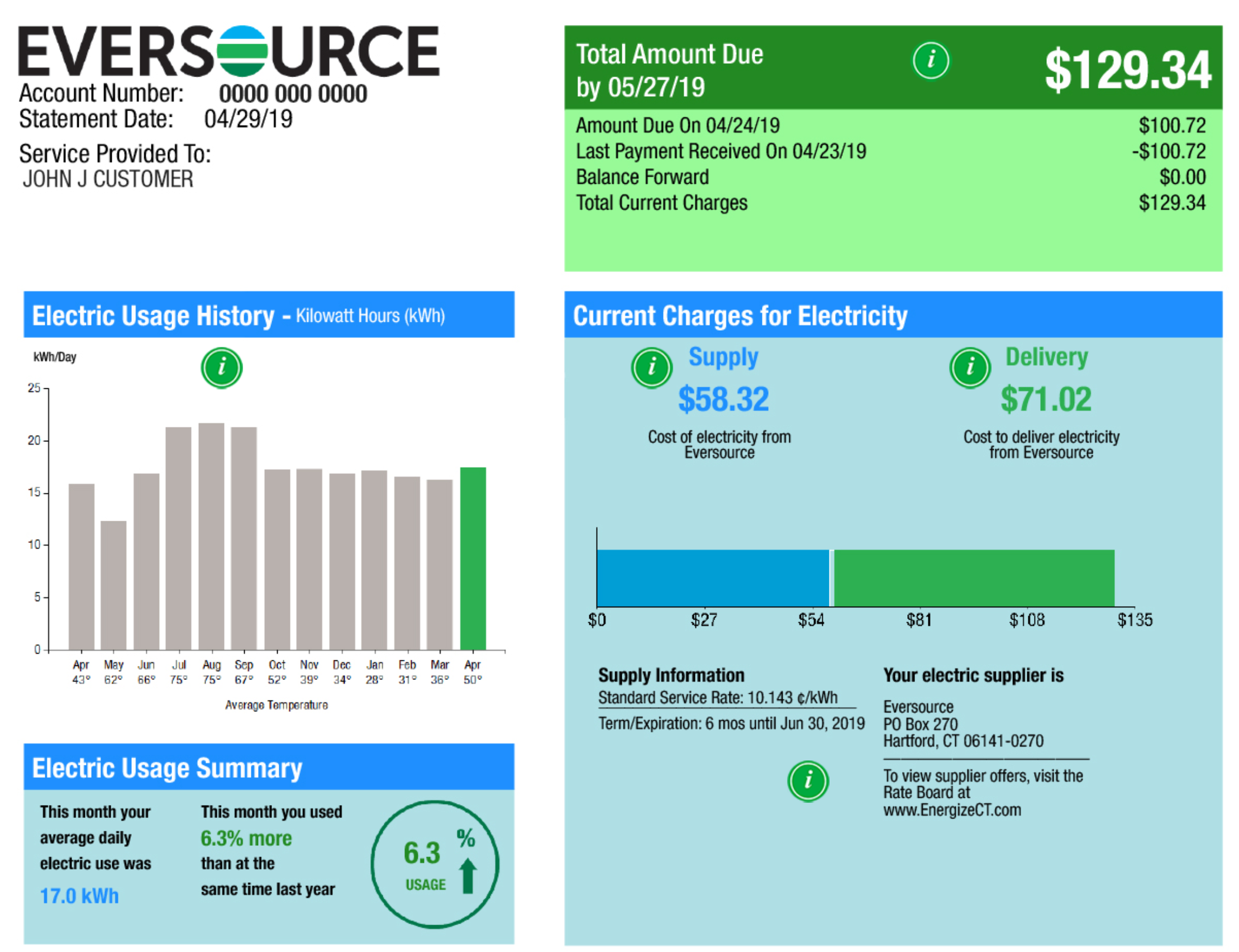
Take Charge of Your Electric Bill: What You Need to Know
Most of you are aware that electric rates effectively doubled starting in January. Ouch! But, did you know that there is a way that you can relieve that cost?
First, it is important to understand your bill: the two components of the rate and what you can control. So let’s take a closer look at the bill (example above). On the right hand side of your bill, under “Current Charges for Electricity” there is a “Supply” charge and a “Delivery” charge. While you cannot change who delivers your electricity – Eversource or United Illuminating – you CAN change who supplies it and switching your supplier is EASY!
Secondly, it is important to know that electricity supply rates are set twice a year – on July 1st and January 1st. Providers are “estimating” what their costs will be when they set rates and there can be wide variability based on a number of factors. To learn more about this check out the recent presentation at Westport Public Library, Energy Rates, that was led by Representatives Steinberg, Hughes and Senator Maher.
90% of Eversource customers are currently on standard service for supply and as of January 1, 2023 that rate increased from 12.050c/kWh to 24.172c/kWh! Alternate suppliers offer rates ranging from 10.67c/kWh (Town Square Energy) to 15.99c/kWh (Constellation) depending on contract details.
In December of 2021 I changed my electric supplier from Eversource to Constellation NewEnergy and signed a 19 month contract. I just renewed my contract with Constellation which will roll over starting in May. Constellation’s current rate is 15.99c/kWh for a 36 month contract (compared to 27.17c/kWh with Eversource). It is important to note that there are a variety of options offered from alternate suppliers including the number of billing cycles and cancellation policies – read the details of the contract you sign! But, with a little time and attention it is definitely worth checking the rates every 6 months (as rates do vary from winter to summer) to get the best rate you can for the supply charge.
Here’s how to Start:
- Go to www.EnergizeCT.com
- Click on the Rate Board tab and then click on “Compare Energy Supplier Rates”
- Select Eversource residential or United Illuminating Residential and click Search and Compare
- The first offer will be Eversource or UI Standard offer, followed by the other offers in order of lowest to highest. Review the offers and select the one that best meets your needs. Click on Enroll Now.
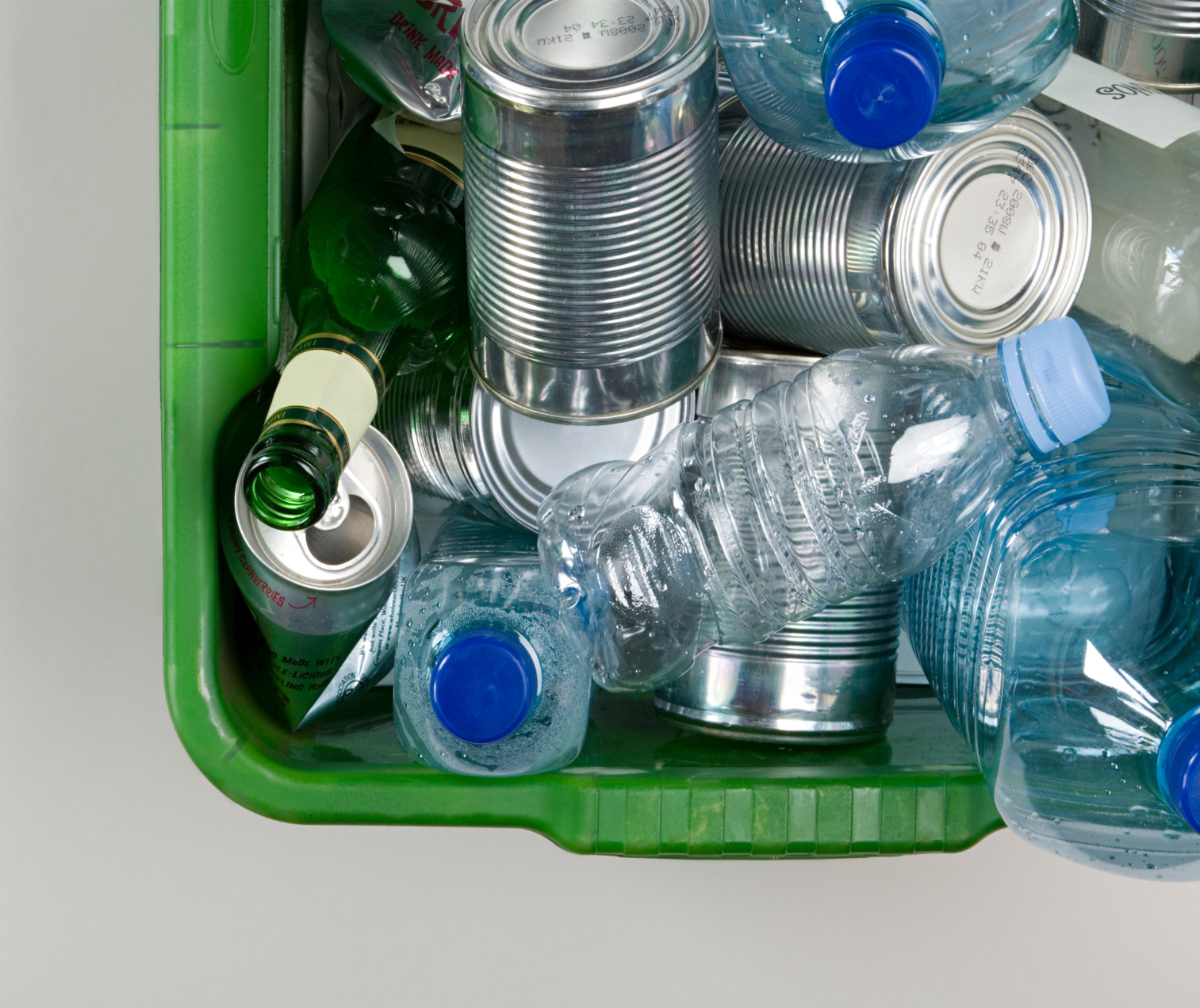
A Brief History and Current Update on Recycling
Recycling in the U.S. is far from perfect: our current recycling rate for plastics is less than 5% while Americans generate more plastic than any other nation in the world at 285lbs/person/year. To satiate consumer demand the plastic industry is making 300 million tons of new plastic annually, 50% of which is single use! This far exceeds capacity in the lagging recycling infrastructure.
Early 20th century “recycling” consisted of Repair, Repurpose and Reuse. However, after WWII, there was movement away from these concepts as increased productivity led to demand for convenience and “time saving” products, coinciding with improvements in manufacturing and distribution. The era of single use was born; paper towels, paper and plastic serveware and disposable packaging all ended up in landfill. Then, as U.S. landfills started to reach capacity in the 1980’s, the environmental movement found a solution: recycling.
Through most of the 21st century, China was the main destination for recycled materials including paper, glass, scrap materials and (importantly) plastic. American recycling practices shifted from separating recycling (dual stream) to single stream (where it all goes in the bin together) to reduce costs. Recycled materials were gathered, baled and shipped off to China who was (and remains) the largest producer of plastic goods. China’s inexpensive labor, efficient recycling systems and need for these resources made the world’s offcast recyclable items valuable. Furthermore, their tolerance for contamination was high – bad recycling habits were developing around the world. At its peak, the U.S. was estimated to export 70% of its plastic to China, however, only about 9% of that was being recycled. The remainder was landfilled or found its way into waterways and the ocean.
In 2018, in response to a burgeoning environmental crisis, China passed the “National Sword”. This legislation banned many scrap materials and imposed strict restrictions on all other recyclables. The import of plastic in China immediately dropped by 99%. The U.S. shifted exports of recycled materials to other countries until many instituted similar bans (although we still export an average of 1 million metric tons of plastic per year, 20-70% of which is estimated to be unusable and ends up in landfill).
China’s refusal to accept our recyclables set the U.S. municipalities scrambling. There was virtually no domestic infrastructure for recycling with massive supply and diminished demand. Suddenly, American communities were required to pay for their recycling. Up until recently, recycling has not been federally regulated or mandated; divergent interests between recyclers, haulers, manufacturers, consumers and communities have led to widespread confusion, frustration and failure at every level. Prior to National Sword, the U.S. was generating up to $20/ton for our unsorted, baled, single stream recycling. In contrast, in 2021 Westport SPENT $55/ton to have our recycling processed.
If It’s not perfect, Why Recycle? It is still part of the solution to waste and has benefits, including:
- Saving energy – recycled materials almost always use less energy to produce than new (paper/plastic/glass)
- Conserving natural resources – extract less from the Earth and protect natural resources such as trees, oil water and metals
- Reducing greenhouse gas emissions
- Creating jobs
- Decreasing landfill dependency
So, where are we now?
In 2021, the EPA announced a Recycling Strategy with a goal to achieve a 50% national recycling rate by 2030 (up from the current rate of 32% ). The EPA defines recycling as “a series of activities that includes collecting materials that would otherwise be considered waste, and sorting and processing recyclables into raw materials such as fibers, and manufacturing raw materials into new products.” Specific objectives of the EPA Recycling Strategy included improving markets for recyclables, increasing and improving collection, enhancing policies and programs to support recycling and contamination reduction through outreach and education.
Beyond these objectives and perhaps, more importantly, is the “Circular Economy” approach that the EPA plans to implement. Recycling addresses a product only at the end of its life, whereas a Circular Economy considers the sustainability of a product at all stages from the beginning to end (“cradle to grave”). It aims to reduce material use, redesign materials, product, and services to be less resource intensive, and recapture “waste” as a resource to manufacture new products. The circular economy ensures that materials are in use for as long as possible, resulting in the most minimal waste.
As part of the Infrastructure Bill, the EPA allocated 375 million dollars for recycling infrastructure and recycling education program grants. The Solid Waste Infrastructure for Recycling (SWIFR) grant program will provide funds to states, territories and tribal governments for projects like municipal recycling program improvement and upgrades to local waste management systems including plastic recycling. Funding to recipients will commence in the spring of 2023.
Moving Forward:
What can you do as an individual consumer while recycling infrastructure and educational programs catch up with our current and excessive production of items?
1 – REFUSE. Say no to excess and unnecessary waste. Say no to the condiments and service wear when you order take out if you are eating at home. Say no to individual plastic bottles and bring your own reusable water bottles & mugs.
2 – REUSE. There are a MULTITUDE of options to reuse/repurpose everything from glass jars to old textiles. A quick google search will yield another life for almost any item you can think of. Consider repairing what you have already to make it work again. If you reuse and repurpose items that already exist, you are creating less waste.
3 – REDUCE. Be thoughtful in your purchasing. Reduce dependency on harmful, wasteful, non-recyclable products. Can you use less disposable paper towels if you also incorporate some reusable, washable ones in your home?
And lastly, BUY RECYCLED. In most cases, the biggest environmental benefit of recycling comes not from avoiding incineration and landfilling but from substituting recycled materials for virgin resources in production,” said Reid Lifset, an industrial environmental management expert at the Yale School of the Environment.
Buying recycled products:
- Creates demand (and therefore a market) for materials collected in residential and business recycling programs, increasing their value and strengthening the loop of continuous recovery
- Reduces the need for additional disposal capacity
- Air and water pollution is reduced and natural resources, including water, are conserved
- Energy is saved
- Greenhouse gas emissions that contribute to global warming are reduced
- Supports the development of green technologies

Going Solar in CT: Everything You Need to Know
This article was written by Erin Kenney for CT Post. Original article published here.
If you’ve been considering a switch to solar power but find yourself overwhelmed by the process, this page is for you. We’re sharing seven steps to go solar in CT — from understanding federal and state cost incentives to estimating process hacks. In the next few minutes, you’ll know everything you need to know about the CT solar process.
Zero upfront payment, low maintenance costs, and hefty lifetime savings are just a few reasons to switch to solar in CT, and by using this straightforward guide and connecting with an expert from one of the best solar companies in CT, you can leap to clean and renewable energy in a few simple steps; that’s if you decide going solar is the right choice for you.
7 Steps to Going Solar in Connecticut
Step 1 Find a solar contractor & schedule the initial consultation Step 2 Familiarize Yourself with the Estimating Process Step 3 Understand how solar panels are priced in CT Step 4 Identify the right financing options for you Step 5 Save on solar in CT with incentives Step 6 Obtain the proper permits Step 7 Have your solar panels installed Step 1: Find a solar contractor & schedule the initial consultation
Making the switch to renewable energy should be a stress-free process, but only if you’re working with the right solar company in CT. Reference customer reviews on Angi and Houzz for first-hand accounts and review the top solar providers featured in The Best Solar Companies in CT, an interactive list to help homeowners find vetted solar providers near you. After gathering your shortlist, it’s time to get started with initial consultations.
When making calls to CT solar companies, look for the representative you communicate with to be patient and willing to speak in-depth about various topics, like solar panel warranties and system maintenance requirements. A top-notch solar company in CT should offer both labor and product warranties spanning at least ten years for all-encompassing coverage. Some companies don’t cover labor, so it’s a good rule of thumb to check on this during your consultation.
This is your chance to get specific answers about all aspects of the solar conversion process, so don’t be afraid to ask any and every question that comes to mind. While there may be quite a few elements to discuss with your solar salesperson, understanding the estimating process is perhaps the most crucial factor when choosing the best solar company in CT.
Step 2: Familiarize yourself with the estimating process
Every residential solar installation process in CT begins with a solar estimator. Estimating is the process of gathering data from many different sources and using it to produce a cost estimate. Typically, solar panel companies look at your last 12 months of energy usage via electric bills to inform their quote, but other factors that contribute to cost include the pitch of your roof and the amount of tree coverage surrounding your home. Verify the estimate is honest and accurate by studying your last year of electric bills beforehand and ask the salesperson to walk you through their quote to understand the factors at play.
A reputable residential solar company has a resume of precise estimates ensuring homeowners aren’t blindsided by cost increases when it is time for installation. Comparison shopping from a few solar providers is smart, but beware, the cheapest option does not always mean it’s the best choice.
Expert Tip:
Experts at Shoreline Solar, a CT solar panel company based in Branford, CT, say that in most cases, the monthly payment is locked and no changes occur post-estimate. You can have peace of mind knowing surprise expenses are uncommon.
Step 3: Understand how solar panels are priced in CT
Solar energy costs are calculated in kilowatts, which contain 1,000 units of electricity. According to Everlast Energy, the average-sized residential solar system clocks in at around 10 kilowatts. The total system price can range from $15,000 to upwards of $100,000 for large estates, according to Shoreline Solar, but the average cost for solar in CT typically falls between $25,000-$45,000. Keep in mind this cost should be itemized in your estimate, clearly defining the price breakdown of labor, solar panels, installation, and permit fees.
Solar experts estimate that going solar in CT reduces your electricity bill payments between $30,000 to $32,000 over 20 years, so in many ways, the conversion pays for itself.
Be advised: your solar estimator may suggest a roof replacement if your roof is over 15 years old. However, a quick roof rejuvenation treatment for aging roofs is often enough to offset damage before going solar in CT.
Expert Tip:
According to Alex Ciccio and Joshua Jackson, solar experts at Everlast Energy, a CT solar company based in Rocky Hill, CT, only about 30% of homes need a full roof replacement. Should you have to replace your roof, the cost of roof replacement and solar panels can often be combined for an easy, affordable payment plan.
Step 4: Identify the right financing options for you
When considering solar, you have several options for payment, including purchasing, leasing, and financing. If you finance your solar installation through a solar company in CT, you can expect payments to be set on a 20- or 25-year term at a 1.99% interest rate, based on our findings. In some cases, payment timelines can also be customized.
Power Purchase Agreements
Power Purchase Agreements (PPA) may be attractive for CT homeowners interested in going solar through a third party. According to the Solar Energy Industries Association, a PPA is a financial agreement between a homeowner and a developer, wherein the developer arranges for the design, permitting, financing, and installation of a solar energy system on a customer’s property at little to no cost.
Essentially, the third-party developer handles a homeowner’s entire solar journey, from installation to system operation over a five to 25-year period. At the end of the PPA term, a customer may be able to extend the contract, have the developer remove the system, or decide to buy the solar energy system from the developer.
Be warned that opting for a PPA discredits you from the landscape of tax credits and incentives available on a state and federal level, so it may not be the best option for everyone. (Solar Reviews)
Step 5: Save on solar in CT with incentives
Thanks to state and federal initiatives to increase renewable energy use, people considering switching from traditional energy to solar energy have several discount and payback options. The Connecticut-backed Residential Renewable Energy Solutions program allows residential solar users to sell conserved energy back to their utility company at a fixed 20-year price through one of two tariff program options: Buy-back and Netting.
The Federal Tax Credit for Solar Photovoltaics, also known as the Investment Tax Credit (ITC), is another way to save big on solar in CT. The program offers a 30% tax credit on installations occurring between 2022 and 2032. For a full breakdown — including more ways to save — read through our solar cost guide.
Step 6: Obtain the proper permits
After you’ve accepted the estimate and signed a contract for solar installation through your preferred Connecticut solar provider, the plan will be checked by a building inspector for compliance with local building codes. This inspector also verifies that all the proper permits are in place so work can begin on your home.
Permit stipulations include, but are not limited to, home distance to wetlands, relation to core forestry lands, and distance from flood land areas. (CT.gov) Getting cleared for installation after the inspection and permitting process may take several months.
Step 7: Have your solar panels installed
Once you’ve wrapped up the permitting process, it’s finally time to transition to solar! The installation process can be quick; typically solar installations are completed in as little as six hours or as much as three days. From there, an electrician will connect your system to the Connecticut power grid to activate your panels and install an electrical meter that measures your solar production.
It’s important to note that your contractor must be a certified E-1 Unlimited Electrical Contractor to complete both the electric grid and panel connection. A PV-1 Limited Solar Electric Contractor may also be on-site solely to connect your residential solar panels, as they are not licensed for power grid connection. (Ct.gov) Once installed, it will take between one and six weeks for a final city and utility company inspection to grant final approval. (Solar Reviews)
So, are you making the switch to solar in CT?
How often does something have both a financial and humanitarian upside? By using renewable energy, you will save tens of thousands of dollars while contributing to the health of our planet. It almost sounds too good to be true, but here’s the thing — it’s not! Need more information before starting your residential solar panel journey? Explore the steps to choose the best solar company and how to access stellar solar savings with our additional resources for going solar in Connecticut.
In the meantime, bookmark this page or save the handy recap of the seven steps to going solar in CT.
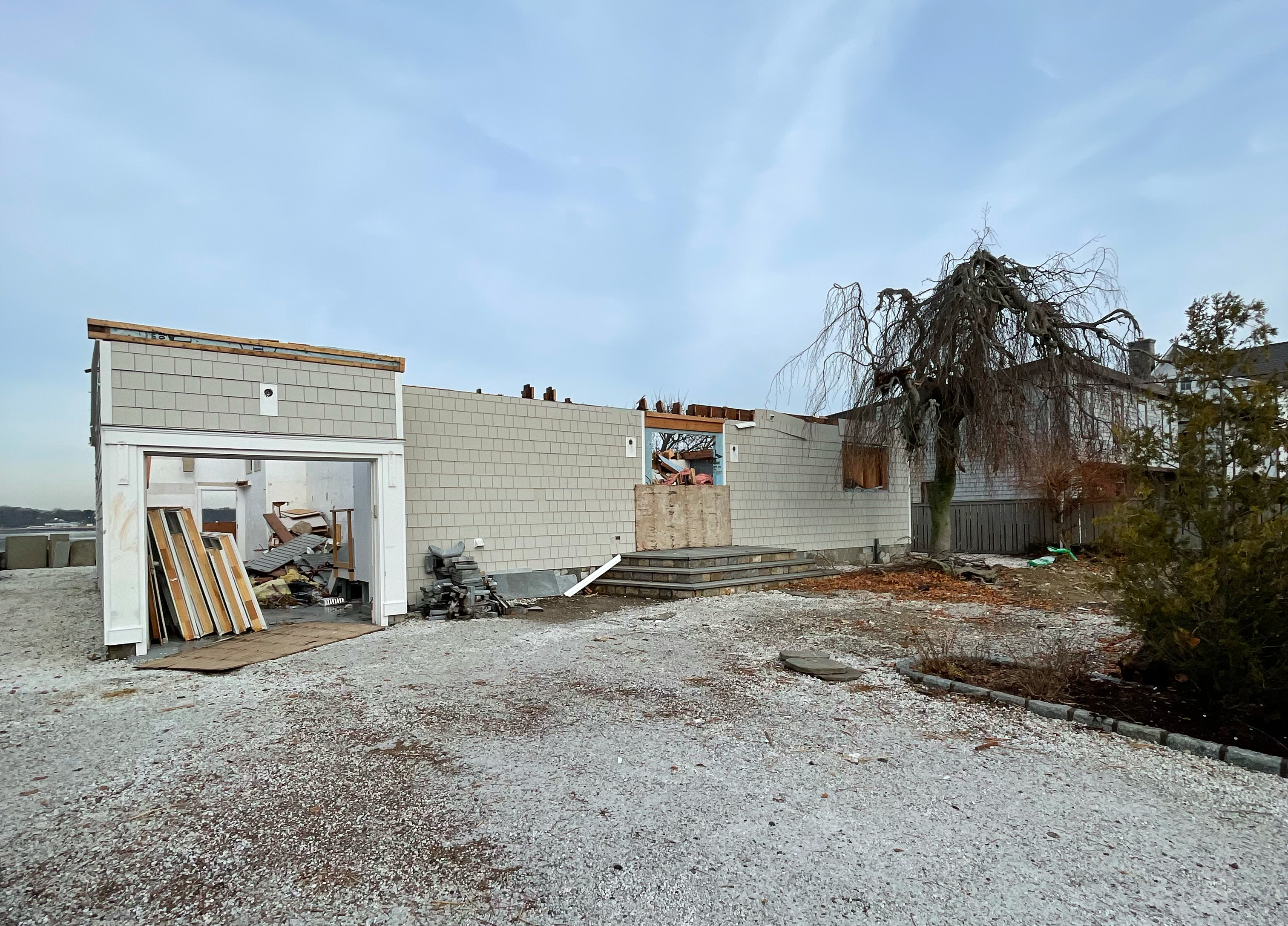
Sustainable Westport Superstar: Bill & Kate Weber

When longtime Westporters, Bill and Kate Weber, decided to move from Old Hill to Saugatuck Island, it was a bit of kismet: the home they bought, 105 Harbor Rd, was owned and relatively recently renovated by good friends of theirs. The Webers wanted to make some changes to the second floor of the home. However, when they consulted with local architecture firm, Tanner White, they were told that because the house was not FEMA-compliant, any work they did would require them to pull a permit and raise the house up to the FEMA prescribed level. The architect’s advice: because we have to make the house FEMA-compliant to do the work you want to do anyway, it makes more economic sense to start from scratch.
The Webers did not feel good about destroying a perfectly good home, so they began researching other options. A friend fromWashington, D.C. told them about Second Chance, Inc., a non-profit organization based in Baltimore that provides “people, materials and the environment with a second chance.” They deconstruct buildings and homes, salvage usable materials, and make those and other donated items available to the public for reuse. With the revenue generated from the sale of those items, they provide job training and workforce development for people with various employment obstacles in the Baltimore area. Second Chance seemed like a great fit for what they were looking for.
As a first step, Second Chance came up to Westport and assessed the value of the building materials and appliances that could be salvaged from the home. You can choose to deconstruct only the more valuable items or everything in the home. The Webers chose everything. Next up, Second Chance sent a crew of 8 people and spent two weeks deconstructing the home, a week on the inside and a week outside. They worked rain or shine and neighbors commented on how hardworking the crew was. They took every door, window, floorboard, fixture, appliance, tile and shingle. After they finished, the Webers still had to perform demolition work on the foundation and non-salvageable materials, however, the majority of the house was gone to Baltimore.
Because Second Chance is a 501(c)(3) non-profit, the Webers were able to make the home a charitable deduction for the appraised value of the materials salvaged. “The economic benefit is nice,” says Bill, but it was not the primary motivating factor in their decision to use Second Chance. “The first driver was avoiding all that material ending up in the landfill, and the second driver was supporting Second Chance’s mission.”
Check out Second Chance’s website for more information.
Learn more about how to build or remodel more sustainably, including information on deconstruction here.
THANK YOU, Bill & Kate Weber for being a Sustainable Westport Superstar!
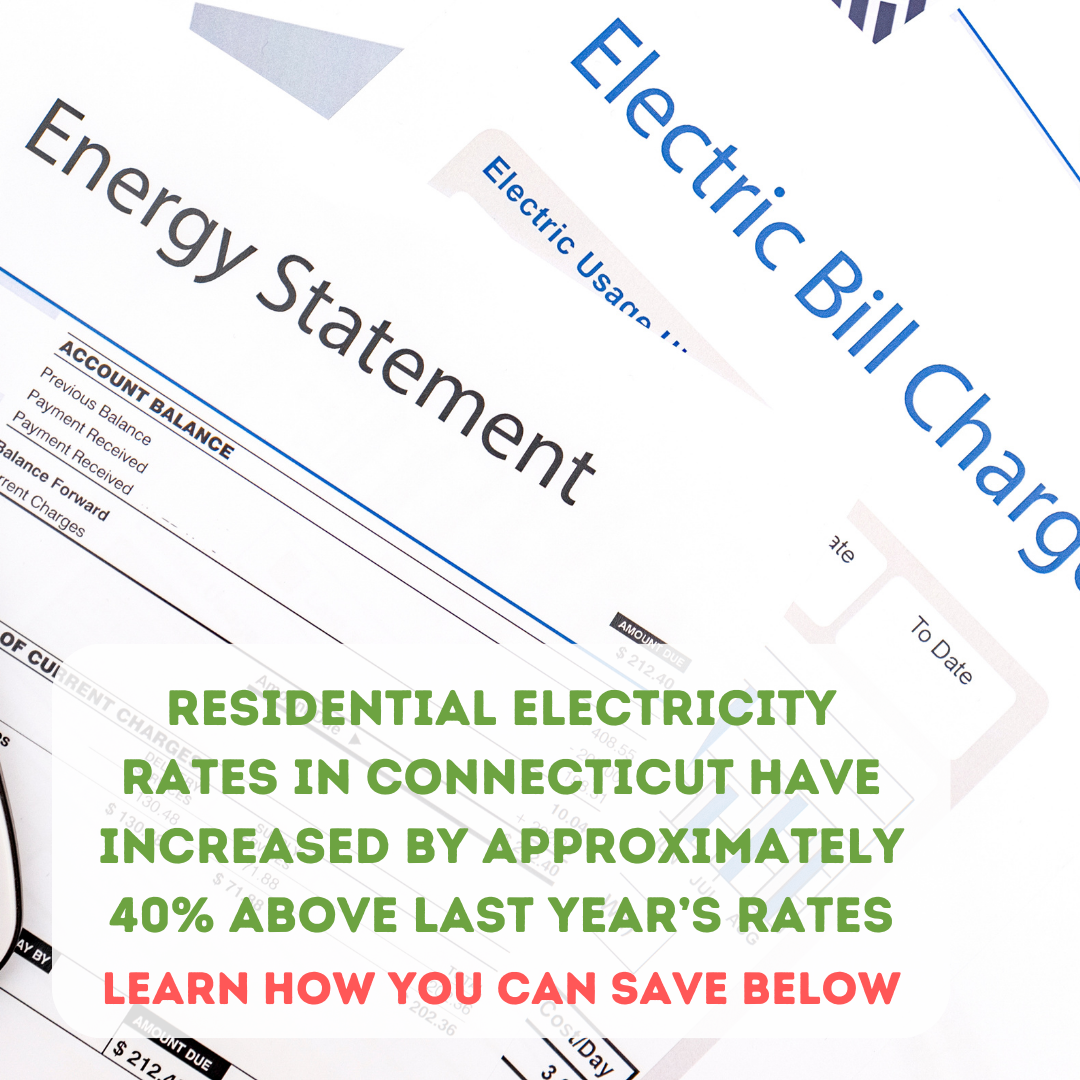
In-Home Energy Performance Assessment? Yes!
You have probably noticed that residential electricity rates in Connecticut have increased by approximately 40% above last year’s rates, and while Governor Lamont and other state officials have announced that they are going to do more for customers in the state to provide short-term relief, there is action you can take as an individual to help lower your utility bills this winter. The HERS program is regarded as the easiest, fastest, cheapest way to reduce your home energy bill.
An in-home energy performance assessment (sometimes referred to as an energy audit) helps make your home more energy efficient by identifying and correcting “problem” areas as well as making recommendations that reduce energy consumption resulting in lower energy bills. It’s an examination of your home, the heating and cooling systems as well as insulation and appliances.
What happens during an in-home energy performance assessment?
The assessment starts with a walk-through inside and outside the home by a utility-approved technician to determine any obvious visible problem areas as well as an examination of heating and cooling systems and insulation levels. The second part of the audit involves a blower door test, in which the technician determines how tight the structure’s envelope is by checking for air leakage. The front door is sealed and a large fan is placed inside which pulls interior air out, lowering the air pressure inside the home and forcing outside air to come through any cracks or holes. The technician will then go around and seal as well as add weather stripping to exterior doors. This part of the assessment may also involve air flow measurement which tests air flow and your duct system. The third part of the assessment is a thermographic scan to measure energy consumption using equipment like infrared cameras, surface thermometers and furnace efficiency meters. In addition, the technician provides helpful information on LED lighting, water saving measures and identification of older appliances. At the end of the audit, you are provided a comprehensive Home Energy Report of the work that’s been done as well as other “deeper” energy-saving options that you might want to consider including REBATE information.
My experience with an in-home energy performance assessment:
We did our 1st home energy performance assessment 9 years ago and again this past December. With this most recent assessment, the technician climbed up into our unfinished attic space and caulked around the chimney (where it meets the roof) resulting in an estimated annual savings of $487! The technician insulated a water pipe in the basement netting another estimated savings of $22, as well as replacing weather stripping at the front and back doors. They recommended insulating the basement ceiling and replacing our old, energy inefficient washing machine and refrigerator and the one remaining window in our house that hadn’t been replaced (a source of heat escape). They provided us with Rebate forms for all four suggested upgrades and replacements.
Is an in-home energy performance assessment worth doing?
Absolutely! For just a $50 co-pay the average home receives approximately $1000 in services and realizes $200-$500 in savings on their annual energy bill. There are programs for both income eligible households and multifamily properties. For more information on the Home Energy Solutions Program and to schedule an appointment visit EnergizeCT.
Are you passionate about residential energy and the rising costs of electricity in our homes? Maybe you are interested in spreading the word on sources of clean, renewable energy? Join the Sustainable Westport Residential Energy team as we work to educate, inspire and support residents to increase their home’s energy efficiency, save money and advance Westport’s resolution to reach net zero by 2050.
Westport Recognized by Live Green Connecticut for County-Wide Collaboration
Live Green Connecticut, a Sustainable Development Network dedicated to connecting community members to each other and to local initiatives that collectively build a bridge from local efforts to the achievement of collective sustainability goals, recognized the Town of Westport for outstanding county-wide collaboration through participation in the Sustainable Fairfield County working group. The working group connects towns throughout Fairfield County and encourages collaboration, information and resource sharing, and cross-promotion of member programming.
Sustainable Westport represents the Town of Westport at Sustainable Fairfield County meetings. “Participating in the Sustainable Fairfield County working group has provided us with the opportunity to more seamlessly collaborate with other towns and share best practices on various initiatives. We are all working towards the same goals, and are learning and growing together. We are looking forward to continuing our participation in 2023.” shared Johanna Martell, Co-Director of Sustainable Westport.
Dawn Henry, Sustainable Westport’s Electric Vehicle Liaison, attended the recognition ceremony on behalf of Westport. Henry reflected on the experience, “the group has been a great resource for knowledge and best practices that are helping to accelerate the adoption of electric vehicles, particularly when it comes to things like electric school buses and police fleets as well as the expansion of EV charging.”
If you would like to participate in upcoming Sustainable Fairfield County meetings, please contact Ryan Boggio at ryan@livegreenct.org or Dapne Dixon at daphne@livegreenct.org.
